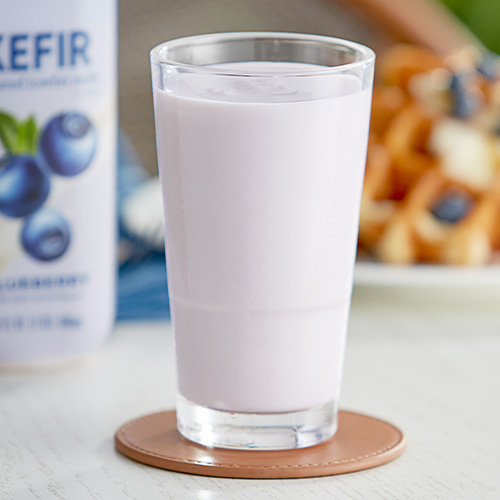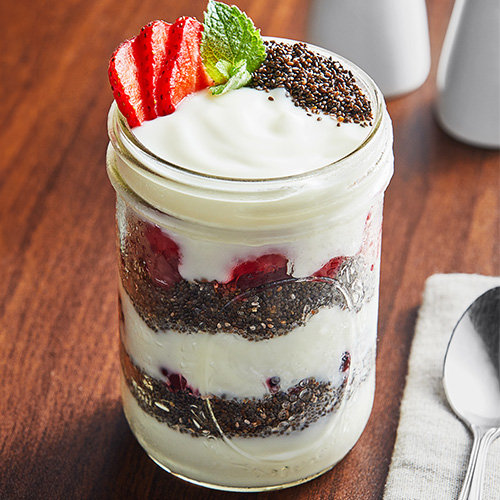Yogurt, a versatile and nutritious dairy product, has gained popularity in the commercial food industry for its wide range of applications. Whether used as a standalone snack, a base for frozen desserts and smoothies, or an ingredient in savory dishes, yogurt offers a creamy texture and tangy flavor that enhances a variety of culinary creations. With options such as Greek yogurt, drinkable yogurt, and plant-based alternatives, businesses can choose the type of yogurt that best suits their menu offerings and customer preferences.
Shop All YogurtDifferent Types of Yogurt
There are several types of yogurt to choose from, each offering unique flavors and textures. We created a list of the most popular yogurt types so you can find the right one for your menu:
1. Plain Yogurt

Plain yogurt, also known as unstrained cow’s milk yogurt or dairy yogurt, is made by fermenting milk with live bacterial cultures, resulting in a creamy and tangy food product. One of the defining features of plain yogurt is the use of specific strains of bacteria, such as Lactobacillus bulgaricus and Streptococcus thermophilus, in the fermentation process. These bacteria help break down the lactose in milk. They also give traditional yogurt a rich probiotic content which promotes gut health. Regular yogurt can be enjoyed plain or flavored with fruits, honey, or toppings like granola, chocolate, nuts, and shredded coconut. While typically made from cow’s milk, dairy yogurt can be made from different types of milk, like goat's milk and sheep's milk, with slight variations in their consistency and flavor profiles.
- What Does Plain Yogurt Taste Like? Plain yogurt has a refreshing and slightly sour taste with natural acidity and dairy richness.
- Plain Yogurt Texture: Smooth, almost pudding-like
2. Greek Yogurt

Greek yogurt is made by straining excess liquid and whey from yogurt, resulting in a thick and creamy texture. With the whey removed, Greek yogurt ends up with a lower lactose content than regular yogurt, making it easier to digest for those with lactose sensitivities. Greek yogurt typically contains double the protein of regular yogurt, earning it a popular spot in the diet of athletes and fitness enthusiasts. This versatile yogurt can be enjoyed on its own, topped with fruits and nuts for a nutritious snack, or used as an ingredient in dishes like tzatziki sauce and types of cake. Its thick texture makes it a great substitute for sour cream or mayonnaise in recipes.
- What Does Greek Yogurt Taste Like? The taste of Greek yogurt can be described as rich, slightly tangy, and more tart compared to traditional yogurt. This tanginess comes from the straining process that removes excess whey, resulting in a concentrated flavor.
- Greek Yogurt Texture: Thick and velvety, maintains its structure when scooped
Greek Yogurt vs Regular Yogurt
The difference between Greek yogurt and regular yogurt is that Greek yogurt is strained to remove whey, resulting in a denser consistency, lower lactose content, and higher protein levels. Greek yogurt has a tangier and more pronounced flavor compared to regular yogurt, while regular yogurt is smoother and more mild in flavor.
3. Kefir

Kefir is a fermented milk product that is made by adding kefir grains to milk. It undergoes a fermentation process that results in a tangy and slightly effervescent drinkable yogurt. Kefir has a high probiotic content, which promotes gut health and aids in digestion. For this reason, kefir has been gaining popularity and trending in the foodservice industry. Kefir can be enjoyed on its own or used as an ingredient in smoothies, salad dressings, or baked goods. Its tangy flavor and creamy texture make it a versatile ingredient that cafes, smoothie bars, and health food stores, can incorporate into their menu offerings to cater to health-conscious consumers. It is often sold in individual bottles, so customers can take this drinkable snack to go.
- What Does Kefir Taste Like? Kefir has a tangy and slightly sour taste. It is often described as having a refreshing and complex taste profile that is both creamy and tart.
- Kefir Texture: Liquid and effervescent, can be easily poured
Kefir Yogurt vs Regular Yogurt
The difference between kefir and yogurt is that kefir is a fermented yogurt drink that contains a higher probiotic count than regular yogurt. It is a thin liquid with an effervescent quality. Regular yogurt, on the other hand, is a thicker, creamier product that is lower in probiotics and requires a spoon to be eaten.
4. Skyr

Skyr is a traditional Icelandic yogurt that has gained popularity in recent years due to its unique taste and nutritional benefits. Made from skim milk with live cultures, skyr is a thick yogurt that is high in protein and low in fat. It is strained to remove excess whey, resulting in a rich and velvety texture. The straining process also contributes to skyr's high protein content, with some varieties containing up to 15 grams of protein per serving. This makes it a popular option for individuals following a high-protein diet. While there is some debate on whether skyr is a yogurt or a cheese because of the curds that form during the thickening process, it is often consumed like a yogurt. Icelandic yogurt can be mixed with fresh fruit, honey, or granola for an internationally-inspired breakfast, or it can be used in smoothies, dips, dressings, and baked goods.
- What Does Skyr Taste Like? Skyr has a robust dairy flavor and mild sweetness with some sourness and tang.
- Skyr Texture: Dense and almost curd-like, thick consistency when scooped
Skyr vs Greek Yogurt
Skyr and Greek yogurt are both thick and creamy dairy products that are popular choices for commercial foodservice operations. Skyr, a traditional Icelandic yogurt, is made from strained skim milk and is known for its higher protein content. It has a thicker consistency when compared to Greek yogurt. Greek yogurt is typically made from strained whole milk and has a tangier taste and slightly lower protein content than skyr. Both are considered healthier than plain yogurt and are used in various recipes, from breakfast parfaits to savory sauces.
5. Lactose Free Yogurt

Lactose free yogurt is a popular option for individuals who are lactose intolerant or have a sensitivity to lactose. Lactose is the natural sugar found in milk and dairy products, and some people lack the enzyme needed to properly digest it, leading to digestive discomfort. Lactose free yogurt is made by adding lactase, the enzyme that breaks down lactose, to the milk before the yogurt is cultured. This process helps to predigest the lactose, making it easier for individuals with lactose intolerance to digest the yogurt. Other types of yogurt, like Greek yogurt and skyr, can be produced in lactose free variations. Be sure to clearly label lactose free yogurt options on menus or signage to help customers easily identify options that cater to their needs.
- What Does Lactose Free Yogurt Taste Like? Lactose free yogurt has a slightly sweeter taste due to the conversion of lactose into glucose and galactose.
- Lactose Free Yogurt Texture: Slightly thin and creamy, can vary depending on the type
6. Coconut Yogurt

Coconut yogurt is a popular dairy-free yogurt made from coconut milk. This refreshing yogurt is a great option for those who are lactose intolerant or following an alternative diet like veganism. It is also a good source of healthy fats, particularly medium-chain triglycerides (MCTs), and probiotics. While slightly thinner in consistency than traditional dairy yogurt, coconut yogurt has a creamy texture and refreshing flavor that makes it an excellent substitute. It can be used in a variety of applications, including as a base for smoothies, parfaits, frozen cocktails, and desserts. Coconut yogurt is also a versatile ingredient in savory dishes, adding a hint of sweetness and tropical flavor.
- What Does Coconut Yogurt Taste Like? The taste of coconut yogurt is often described as tropical and refreshing, with a hint of natural coconut flavor.
- Coconut Yogurt Texture: Smooth and fluffy, almost whipped consistency
Coconut Milk Yogurt vs Dairy Yogurt
Coconut milk yogurt is a dairy-free yogurt alternative that is suitable for those with lactose intolerance or dairy allergies. It is made from coconut milk and contains healthy fats and medium-chain triglycerides. On the other hand, dairy yogurt is made from cow's milk and is a good source of calcium and protein. Traditional yogurt is thicker and tangier than coconut milk, which has a fluffier consistency and a more tropical taste.
7. Nut Yogurt

Nut yogurt is a popular dairy alternative that offers a range of health benefits and a unique flavor profile. Made by blending nuts with water and probiotic cultures, nut yogurts offer a delicious option for those seeking a plant-based alternative to traditional dairy yogurt. Nuts are a good source of healthy fats, protein, and vitamins and minerals, making nut yogurt a nutrient-dense option for consumers. Almonds and cashews are among the most common nuts used to make nut yogurt. Almond yogurt, for example, offers a subtle nutty taste, while cashew yogurt provides a creamier texture. They provide an excellent base for smoothies and parfaits, or they can be incorporated into baking recipes for added moisture and richness. If using nut yogurts on your menu or in recipes, be sure to clearly label them for those with nut allergies.
- What Does Nut Yogurt Taste Like? The taste of nut yogurt can vary depending on the type of nuts used in the recipe. Almond yogurt has a slightly sweet and nutty flavor, while cashew yogurt tends to be more neutral in taste.
- Nut Yogurt Texture: Smooth and slightly runny, thickness varies on the nut milk used
8. Soy Yogurt

Soy yogurt is made from soy milk that has been fermented with live cultures. It offers a creamy texture and tangy flavor similar to traditional yogurt, making it an excellent option for those who are lactose intolerant or follow dairy-free diets. Soy yogurt is high in protein and a good source of probiotics, which are beneficial bacteria that support gut health and digestion. It is often fortified with additional vitamins and minerals to enhance its nutritional profile. Soy yogurt can be used as a base for smoothies, parfaits, and salad dressings. It can also be incorporated into dairy-free baked goods and vegan desserts.
- What Does Soy Yogurt Taste Like? The taste of soy yogurt is mild and nutty with a subtle soybean flavor. The flavor can vary depending on the brand and any added sweeteners.
- Soy Yogurt Texture: Light and spoonable with a thin consistency
Soy Yogurt vs Regular Yogurt
Soy yogurt, a plant-based alternative to traditional dairy yogurt, is made from soy milk. It is a suitable option for individuals with lactose intolerance or following a vegan diet. It has a similar texture to dairy yogurt but has a slightly more nutty taste with hints of soybean flavor.
9. Drinkable Yogurt

Drinkable yogurt, also known as yogurt smoothie or yogurt drink, is a popular and convenient way to enjoy the benefits of yogurt on the go. This type of yogurt is consumed in liquid form, making it easy to sip and enjoy without the need for a spoon. Drinkable yogurt is available in a variety of flavors, including traditional options like strawberry, blueberry, and vanilla, as well as more tropical flavors such as mango, passion fruit, and pomegranate. Drinkable yogurts are a great source of probiotics, calcium, and protein, making them a quick and nutritious snack or breakfast option for those with busy lifestyles. Commercial establishments such as cafes, smoothie bars, and convenience stores can offer drinkable yogurt as a refreshing and portable beverage option for their customers.
- What Does Drinkable Yogurt Taste Like? Drinkable yogurt typically has a slightly tangy flavor that is often complemented by fruit flavors. Drinkable yogurt can be sweetened with natural sugars or artificial sweeteners, depending on the brand and flavor.
- Drinkable Yogurt Texture: Pourable and creamy, liquid for drinking direct from the bottle
10. Oat Milk Yogurt

Oat milk yogurt is a popular dairy-free alternative that has gained significant attention in the commercial food industry. Made from oats and live bacterial cultures, oat milk yogurt offers a creamy texture and a slightly sweet flavor profile that appeals to a wide range of consumers, including those with lactose intolerance or dairy allergies. Oats are rich in fiber, vitamins, and minerals, making oat milk yogurt a nutritious choice for health-conscious consumers. Due to its neutral flavor profile, oat milk yogurt can be easily incorporated into various recipes and dishes, ranging from smoothies and parfaits to dressings and sauces. This versatility makes oat milk yogurt a valuable ingredient for commercial kitchens looking to cater to customers with dietary restrictions or preferences.
- What Does Oat Milk Yogurt Taste Like? Oat milk yogurt has a slightly tangy flavor and subtle oat taste that pairs well with toppings and mix-ins, like fruits, honey, and nuts.
- Oat Milk Yogurt Texture: Slightly thick and velvety, custard-like
What to Do With Yogurt?
Yogurt can be an extremely versatile ingredient in your kitchen beyond serving it plain. From baking to cooking, here are just some ways to incorporate yogurt into your menu:
- Create Parfaits: Layer yogurt with granola, fresh fruits, nuts, and honey in a cup or bowl to make a delicious and nutritious parfait.
- Blend Smoothies: Use yogurt as a base for smoothies by combining it with fruits, vegetables, and a liquid of your choice for a refreshing drink.
- Make Salad Dressings: Incorporate yogurt into salad dressings by mixing it with herbs, spices, and citrus juice for a tangy and creamy dressing.
- Marinate Meat: Tenderize and flavor meats by using yogurt as a marinade. The acidity in yogurt helps break down proteins, resulting in tender and flavorful dishes.
- Bake with Yogurt: Replace oil or butter with yogurt in baking recipes to reduce fat content while adding moisture and a slight tanginess to your baked goods.
- Dip and Spread: Use yogurt as a dip for fresh vegetables, chips, or pita bread. You can also mix it with herbs and spices to create a flavorful sauce for sandwiches or wraps.
- Freeze for Frozen Treats: Freeze yogurt in popsicle molds or ice cube trays for a healthy and refreshing frozen treat. Add fruits or nuts for extra flavor and texture.
- Cook Savory Dishes: Add yogurt to curries, soups, and stews for a tangy twist. It can balance out spicy flavors and add richness to savory dishes.
From traditional Greek yogurt to dairy-free options like coconut yogurt, there is a wide range of choices to cater to diverse customer preferences and dietary needs. Each type offers unique textures and flavors, making them suitable for different commercial applications in the foodservice industry. Whether used in smoothies, parfaits, dressings, or baked goods, yogurt can enhance the taste and nutritional value of a wide range of dishes. Its popularity continues to grow as consumers seek healthier options, making it a valuable ingredient for commercial kitchens and food businesses alike.








